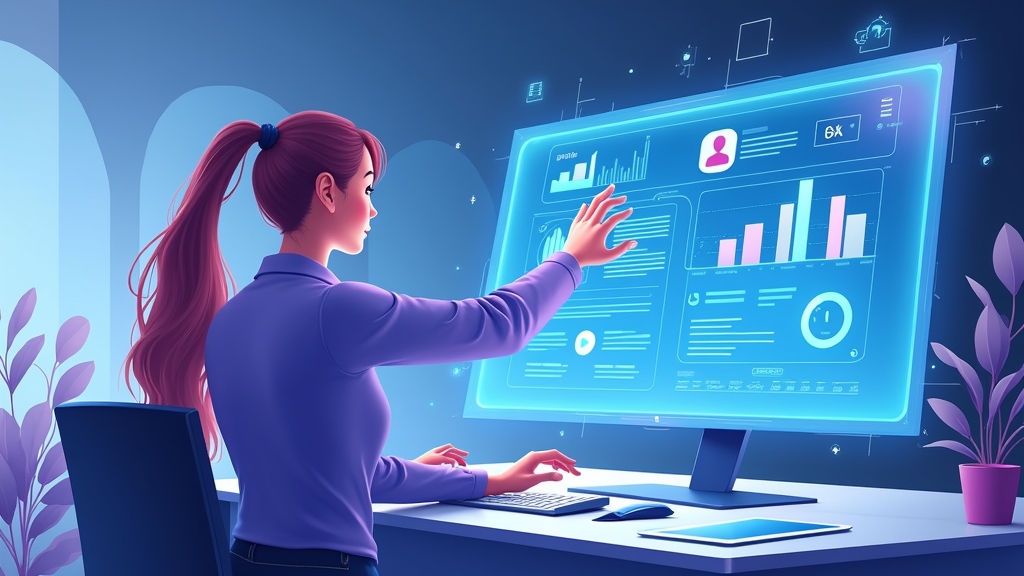Advertising
The Artificial Intelligence Revolution in the Job Search
Imagine waking up and having a virtual assistant who has already selected the best jobs for you, personalized your CV and even trained you for the interview. Sound like science fiction? In 2024, artificial intelligence (AI) is transforming the way we look for jobs, making the process more efficient and less stressful. With tools such as chatbots, matching algorithms and CV analysis platformsThis way, candidates can save hours of manual work and focus on what really matters: standing out.
But how exactly can AI be your ally? Let's start with the basics: automation. Platforms such as LinkedIn It is Indeed already use AI to suggest vacancies based on your profile. Instead of spending time filtering through hundreds of ads, you get precise recommendations. And it doesn't stop there. Tools such as Jobscan analyze your CV and compare it with the job description, showing you where you need to adjust in order to pass the automated screening systems (ATS).
And the results? Impressive. Candidates who use AI report up to 3 times more positive responses from recruiters. Are you letting opportunities pass you by by not taking advantage of these technologies? The answer is probably yes. But don't worry: in this guide, we'll explore step by step how to integrate AI into your job search, from preparation to salary negotiation.
Where to start? First, understand that AI doesn't replace your effort - it enhances it. You still need to have a solid profile and relevant skills, but with the right tools, your path to your dream job is much faster. Let's dive into the details.
How to Use AI to Identify the Best Jobs
Finding vacancies that match your profile is the first challenge. In the past, this meant hours of manual searching and a lot of frustration. Today, AI does the heavy lifting for you. Platforms such as Glassdoor It is ZipRecruiter use algorithms to match your skills, experience and preferences with thousands of opportunities in real time.
For example, let's say you're a Python developer. When setting up alerts in LinkedIn with specific keywords ("Python", "Backend", "Remote"), the AI not only notifies you of new vacancies, but also ranks them by relevance. Have you ever thought about having a "personalized Google" just for jobs? That's exactly what these tools offer.
Advertising
But go beyond traditional platforms. Tools such as Hiration It is Teal use machine learning to suggest companies that match your background - including those you wouldn't even think of applying to. A real case: a marketing professional used Teal and discovered a growing startup that wasn't on his radar. Two weeks later, he was hired.
And here's a valuable tip: don't ignore match scores. Many platforms assign a score (e.g. "90% compatibility") between your profile and the vacancy. If it's below 70%, it's worth reviewing your keywords or considering career adjustments. AI not only shows you where you are today, but also where you can go.
Optimizing Your Resume with AI to Pass the ATS
Have you ever sent out a perfect CV and never heard back? The problem may lie with the automated screening systems (ATS) used by 99% of large companies. This software discards CVs that don't follow certain standards - and that's where AI comes in as your savior.
Tools such as Jobscan It is ResumeWorded analyzes your CV against the job description and highlights what's missing: keywords, formatting, or even the order of the sections. For example, if the vacancy asks for "agile project management", but your CV only mentions "Scrum" once, the AI suggests adjustments to increase your score.
How does it work in practice? A Reddit user shared that after using Jobscan, his response rate went up from 5% to 32%. He didn't change his qualifications - he just adapted the language. Another secret is use action verbs ("led", "optimized", "implemented") that ATSs recognize as indicators of relevant experience.
But beware: don't just copy and paste the job description. Modern algorithms detect keyword stuffing and can penalize you. Balance is crucial. Tools such as Enhancv help create visually appealing and optimized resumes by combining design and AI.
And if you're thinking, "But my CV is already good"-test it. Upload it to one of these platforms and see how it looks. Unpleasant surprises are now better than eternal silence in the inbox.
Preparing for AI-assisted interviews
Passed the ATS? Great! Now comes the most intimidating stage: the interviews. And yes, there's AI for that too. Platforms like Interviewing.io It is Pramp use algorithms to simulate real interviews, with instant feedback on your body language, tone of voice and the content of your answers.
Imagine practicing with a "virtual recruiter" who points out language vices ("um...", "like...") or moments when you've been too generic. How many times have you left an interview thinking 'I could have answered that better'? With AI, this regret diminishes.
A practical example: candidates for jobs at Google and Amazon use the Yoodli, an AI coach who transcribes and analyzes responses. In one case, an engineer realized that he spoke "we" instead of "I" when describing achievements - which diluted his protagonism. After adjustments, he did better in interviews.
In addition, tools such as Big Interview offer banks of common questions by sector (e.g. "Tell me about a conflict at work"). You can record answers and receive tips on improving clarity and confidence. It's not cheating - it's preparation.
And for international vacancies, apps like ELSA Speak train your English pronunciation. AI detects accents and suggests exercises. Remember: by 2024, even your non-verbal communication could be assessed by algorithms in video interviews. Why not get ahead of the game?

Using AI to Personalize Scaled Cover Letters
Cover letters are a pain to write - and worse, many of them don't even get read. But what if you could generate personalized versions in seconds? Tools like CoverDoc It is Kickresume use AI to create tailor-made letters, extracting data from your CV and the vacancy.
How does it work? You enter the job link and the AI generates a draft with phrases like: "My experience in data analysis at Company X prepared me to optimize the BI processes mentioned in the description". All you have to do is adjust the details. One Twitter user reported sending 10x more applications with this technique without losing quality.
But beware of the genericity trap. AI helps structure, but your unique voice must shine. Add a line about why you admire the company (e.g. "I identify with Coca-Cola's mission to innovate in sustainability"). Send CV Coca-cola). Tools such as GoHire even suggest emotional connections based on company values.
For those looking for jobs abroad, the Grammarly (with AI) corrects cultural errors. In one case, a Brazilian wrote "seeking new challenges", which is common in Brazil but sounds generic in the US. The AI suggested changing it to "looking to leverage my skills in X to drive Y results". Small changes, big differences.
Monitoring Your Progress and Adjusting Strategies with AI
Have you sent out 50 CVs and only had 2 replies? AI can diagnose the problem. Platforms such as Teal offer dashboards that show: response rate by sector, companies that return the most and even ideal times to apply.
For example, a graph might reveal that your applications for "product manager" have 20% returns, but "product manager" has 5%. Does the market see your profile differently? It helps to refine your approach. Another story: a candidate saw that remote vacancies responded in 3 days, while face-to-face vacancies took 2 weeks - and she focused on the remote.
In addition, extensions such as Huntr track status (viewed? forwarded?) and suggest follow-ups. If your CV has been viewed but there's been no contact, maybe it's time for a LinkedIn message. AI turns data into actionnot discouragement.
And for those who are stagnating, tools such as Skillsoft recommend courses based on the gaps in the vacancies you can't get. Want to become a "senior"? AI points out which certifications are missing. In 2024, looking for a job is a game of dice-and you have to play to win.
AI in Wage Negotiation: How Not to Leave Money on the Table
Did you get the offer? Congratulations! But accepting the first number can be costly. Platforms like Levels.fyi It is Paysa use AI to analyze millions of salaries and suggest fair ranges based on job title, location and company size.
Let's say you've been offered R$ 8,000 for a Data Scientist position in São Paulo. Levels.fyi's AI shows that the average is R$ 9,500 in similar companies. Why not ask for more? You can argue with real data, not guesses. One Glassdoor user increased his offer by 18% by quoting these figures.
Another tip: chatbots like Salary Negotiation Bot simulate dialogues with recruiters. It teaches phrases like "Thank you for the offer. Based on my experience in X and industry benchmarks, I was expecting Y. Is there any flexibility?". Negotiation is a science - and AI is its laboratory.
What if the company says no? Tools like RippleMatch compare offers in parallel. Perhaps another company will pay more for the same work. In a dynamic market, information is power - and AI puts it in your hand.
The Future of Job Search: AI and Beyond
By 2025, 60% of hiring will use AI at some stage, according to Gartner. And this goes beyond CVs - recruiters are already testing algorithms that assess cultural fit via video and soft skills in online dynamics. Are you prepared for this reality?
Innovations such as MyaAI, a chatbot that conducts initial screenings, shows that the first contact may not even be human. But calm down: AI doesn't replace your essence. It only filters out those who don't fit in. His creativity, resilience and empathy still set him apart.
To stay ahead, follow trends such as:
– Video interviewsplatforms such as HireVue analyze facial expressions and tone of voice.
– Interactive portfoliostools such as About.me use AI to highlight relevant projects automatically.
– Automated networking: apps like Shapr suggest strategic connections based on their objectives.
The final message? Embrace AI, but don't depend on it exclusively. Use tools to optimize time, but invest in self-knowledge and human skills. After all, behind every algorithm, there are still people making decisions. And now you have everything you need to impress both parties.
How about starting today? Choose a tool from this article and try it out for free. Your next job could be just a click away - with the help of artificial intelligence.



